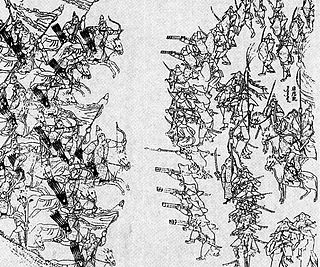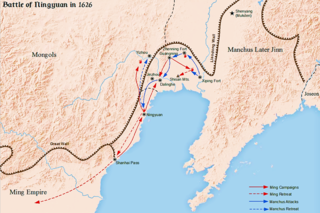
The Battle of Sarhū refers to a series of battles between the Later Jin dynasty and the Ming dynasty and their Joseon allies in the winter of 1619. The battle is notable for the heavy use of cavalry by the Later Jin in defeating Ming and Joseon forces equipped with hand cannons, cannons, and matchlocks.

The Later Jin invasion of Joseon occurred in early 1627 when the Later Jin prince Amin led an invasion of the Joseon Dynasty. The war ended after three months with the Later Jin establishing itself as sovereign tributary overlord over Joseon. However Joseon continued its relationship with the Ming Dynasty and showed defiance in solidifying its tributary relationship with the Later Jin. It was followed by the Qing invasion of Joseon in 1636.
The Seven Grievances was a manifesto announced by Nurhaci, khan of the Later Jin, on the thirteenth day of the fourth lunar month in the third year of the Tianming era of his reign; 7 May 1618. It effectively declared war against the Ming dynasty.
The Jianzhou Jurchens were one of the three major groups of Jurchens as identified by the Ming dynasty. Although the geographic location of the Jianzhou Jurchens has changed throughout history, during the 14th century they were located south of the Wild Jurchens and the Haixi Jurchens, inhabiting modern-day Liaoning province and Jilin province in China. The Jianzhou Jurchens were known to possess an abundant supply of natural resources. They also possessed industrial secrets, particularly in processing ginseng and the dyeing of cloth. They were powerful due to their proximity to Ming trading towns such as Fushun, Kaiyuan, and Tieling in Liaodong, and to Manpojin camp near Korea.
Hūlun was a powerful alliance of Jurchen tribes in the late 16th century, based primarily in what is today Jilin province of China.

The Battle of Ningyuan was a battle between the Ming dynasty and the Later Jin dynasty in 1626. The Later Jin had been waging war on the Ming for several years, and their leader Nurhaci had deemed Ningyuan to be a suitable target for his attack, in part due to advice from a Ming defector, Li Yongfang. Later Jin failed to take the city and Nurhaci was wounded in the assault, dying eight months later. The Ming emerged victorious, marking a temporary resurgence of the Ming army after an eight-year-long series of defeats.

Nara is a clan name shared by a number of royal Manchu clans. The four tribes of the Hūlun confederation (扈倫四部) – Hada, Ula, Hoifa and Yehe – were all ruled by clans bearing this name.
The Haixi Jurchens were a grouping of the Jurchens as identified by the Chinese of the Ming dynasty. They inhabited an area that consists of parts of modern-day Jilin, Heilongjiang, Liaoning and Inner Mongolia in China.

Cuyen was a Manchu prince and eldest son of the Jurchen ruler Nurhaci, the early patriarch of the Qing dynasty. An accomplished warrior, Cuyen was instrumental in the consolidation of Nurhaci's authority among rival Jurchen clans. He also served as the primary civil administrator for intermittent periods in the regime founded by Nurhaci. However, he eventually lost favour with his father because he tried to cast sorcery spells against other princes. He was placed in solitary confinement and died in captivity a few years later.

Nurhaci was a Jurchen chieftain who rose to prominence in the late 16th century in Manchuria. He was a member of the House of Aisin-Gioro, and reigned as the founding khan of the Later Jin dynasty from 1616 to 1626.
Gintaisi, known as Jintaishi or Jintaiji in Chinese, was a Jurchen beile (chieftain) of the Yehe tribal confederation.
The Battle of Dalinghe was a battle between the Later Jin dynasty and the Ming dynasty that took place between September and November 1631. Later Jin forces besieged and captured the fortified northern Ming city of Dalinghe in Liaoning. Using a combined force of Jurchen and Mongol cavalry, along with recently captured Ming artillery units, the Later Jin khan Hong Taiji surrounded Dalinghe and defeated a series of Ming reinforcement forces in the field. The Ming defenders under general Zu Dashou surrendered the city after taking heavy losses and running out of food. Several of the Ming officers captured in the battle would go on to play important roles in the ongoing transition from Ming to Qing. The battle was the first major test for the Chinese firearms specialists incorporated into the Later Jin military. Whereas the Later Jin had previously relied primarily on their own Eight Banners cavalry in military campaigns, after the siege of Dalinghe the Chinese infantry would play a larger role in the fighting. Unlike Nurhaci's failed siege at the Battle of Ningyuan several years prior, the siege of Dalinghe was a success that would soon be replicated in Songshan and Jinzhou, paving the way for the establishment of the Qing dynasty and the ultimate defeat of the Ming.

The Later Jin (1616–1636) was a Jurchen-ruled dynasty of China in Manchuria and the precursor to the Qing dynasty. Established in 1616 by the Jianzhou Jurchen chieftain Nurhaci upon his reunification of the Jurchen tribes, its name was derived from the former Jurchen-led Jin dynasty which had ruled northern China in the 12th and 13th centuries.

The Battle of Fushun was the first military conflict in the war between the Jurchen-led Later Jin and the Ming dynasty. The battle ended in a decisive victory for the Later Jin and resulted in the capture of Fushun and two other nearby fortresses.
The Battle of Qinghe was a military conflict between the Jurchen Later Jin and Ming dynasty in the summer of 1618. The battle ended with the Jin conquest of Qinghe despite taking heavy casualties.

The Battle of Shen-Liao was a military conflict between the Later Jin and the Ming dynasty. In early 1621 Nurhaci, khan of the Later Jin, invaded Liaodong and captured the cities of Shenyang and Liaoyang from the Ming.

The Battle of Guanging was a military conflict between the Later Jin dynasty and the Ming dynasty in 1622. It occurred at and around the Ming's northern city of Guangning, which fell to the Later Jin in 1622.
Rule the World is a 2017 Chinese television series based on the novel Du Bu Tian Xia by Li Xin. It stars Raymond Lam and Tang Yixin alongside Zhang Rui, Jing Gangshan, Li Zhinan and Qu Chuxiao. The series started airing on Tencent Video from 30 November 2017 at 20:00 (CST).

The Chahar–Jurchen War was a military conflict waged between the Chahar Mongols and the Jurchen-led Later Jin dynasty and several other Mongol groups from 1619 to 1634.

The Jurchen unification was a series of events in the late 16th and early 17th centuries that led to the unification of the Jurchen tribes under Nurhaci, a Jianzhou Jurchen leader who had an antagonistic relationship with the Ming dynasty due to their involvement in events early on in his life that led to the death of his father and grandfather. From 1583 to the early 1600s, Nurhaci led a series of military and influence campaigns that led to the unification of the majority of Jurchen tribes. In 1616, Nurhaci established the Later Jin dynasty and ruled as its founding khan.












